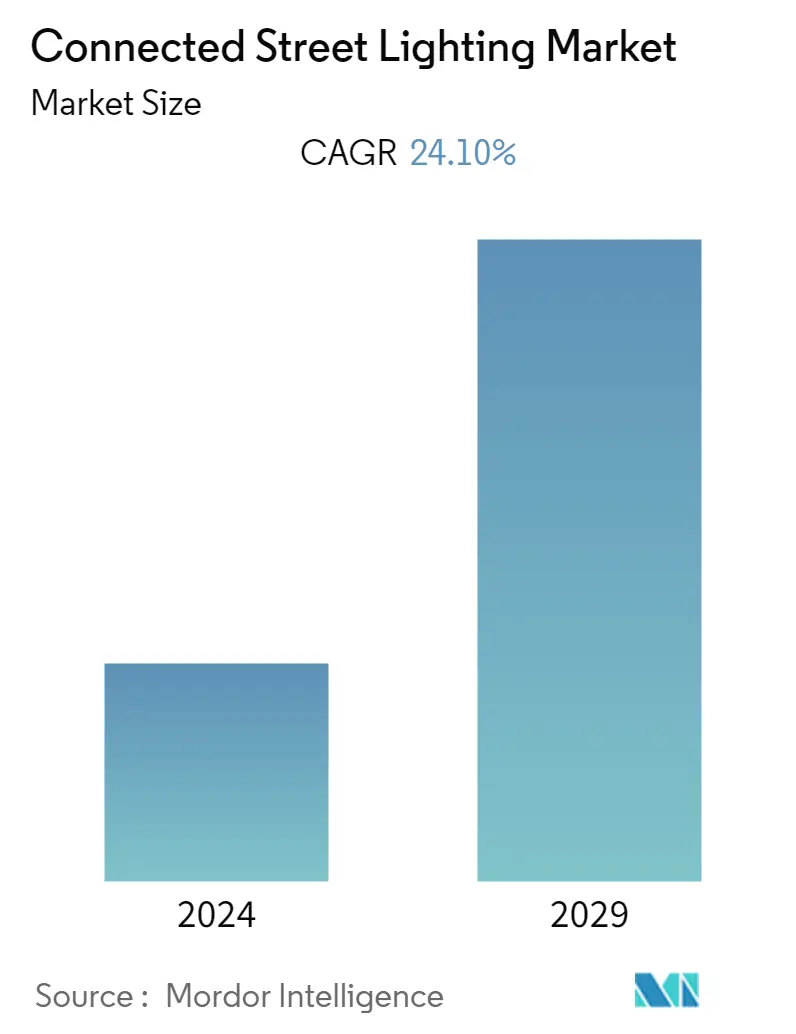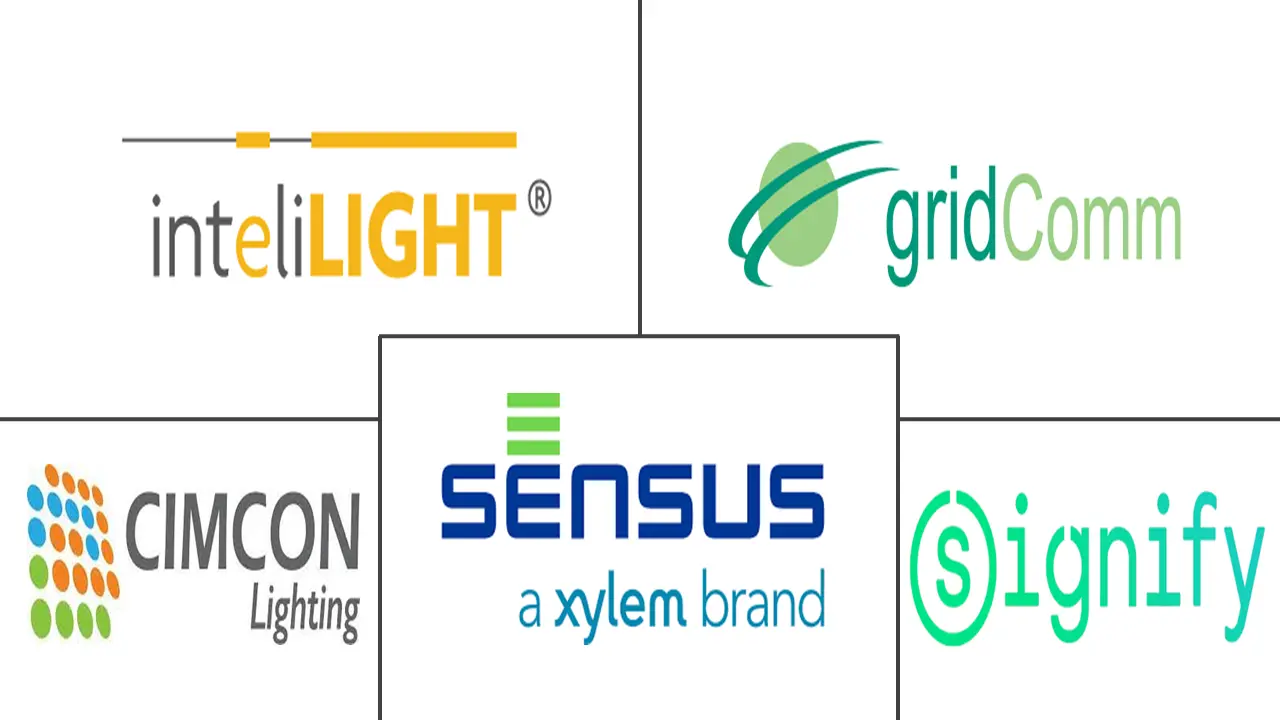Market Size of Connected Street Lighting Industry

| Study Period | 2019 - 2029 |
| Base Year For Estimation | 2023 |
| CAGR | 24.10 % |
| Fastest Growing Market | Asia Pacific |
| Largest Market | North America |
| Market Concentration | Low |
Major Players
*Disclaimer: Major Players sorted in no particular order |
Connected Street Lighting Market Analysis
The connected street lighting market is expected to witness a CAGR of 24.1% over the forecast period. Aided by the rising number of smart cities and increasing awareness of energy conservation and effective lighting methods, the market is expected to grow further in the forecast period.
- Connected street lighting also enables governments to use their street lights for Wi-Fi access. These access points can be used by city personnel to lower their cellular data usage, reducing the city's expenses. Wi-Fi access points can also provide internet access to local businesses and residents, providing the city with new leasing or advertising revenues. In addition, cities can use these Wi-Fi access points to help bridge the digital divide by delivering poorer city residents free or low-cost internet access. Smart parking meters or pay stations attached or connected to light poles can also eliminate the costs associated with trenching for standalone meters and pay stations.
- Additionally, there have been considerable advancements in connecting technologies in recent times. Traditionally, cities trying to centralize connectivity for smart street lighting used proprietary gateways connecting to smaller segments of streetlights that are priorly connected via low-bandwidth communications, such as a power line carrier (PLC) or local RF mesh network adhering to several IEEE standards.
- While various proprietary RF mesh or star networks currently account for the majority of smart street lighting installations, the adoption of low-power wide-area (LPWA) technologies such as narrowband IoT (NB-IoT) and long-range (LoRa) is growing fast, particularly in the European and Asian markets.
- Poor infrastructure in developing economies is expected to limit demand for connected street lights in the next few years. This can be ascribed to underdeveloped network infrastructure and low internet penetration, which leads to less bandwidth availability.
- The connected street lighting market has also been significantly affected by the outbreak of COVID-19 as other industries and companies have been forced to restructure their strategies to deal with the ongoing pandemic. Companies such as Telensa and Itron were among the worst hit due to this pandemic.
Connected Street Lighting Industry Segmentation
Connected streetlights enable the operators to centrally manage the lighting infrastructure through a central management system via wired/wireless network architecture. Sensor suite generally helps the connected streetlight to save energy by detecting several environmental parameters.
The Connected Street Lighting Market is Segmented by Geography. The market sizes and forecasts are provided in terms of value (USD million) for the above segments.
| Geography | |
| North America | |
| Europe | |
| Asia-Pacific | |
| Rest of the World |
Connected Street Lighting Market Size Summary
The connected street lighting market is poised for substantial growth, driven by the increasing proliferation of smart cities and a heightened focus on energy conservation and efficient lighting solutions. This market is characterized by the integration of advanced technologies that enable street lights to serve multiple purposes, such as providing Wi-Fi access and supporting smart parking solutions. These innovations not only reduce operational costs but also create new revenue streams for cities through leasing and advertising opportunities. The adoption of low-power wide-area technologies like narrowband IoT and LoRa is gaining momentum, particularly in Europe and Asia, as cities seek to enhance connectivity and resource management. However, challenges such as poor infrastructure in developing economies and the lingering effects of the COVID-19 pandemic on industry players like Telensa and Itron have impacted market dynamics.
The market's expansion is further fueled by government incentives and collaborations aimed at developing smart cities, which are increasingly reliant on digital technologies to optimize resource use and reduce costs. The demand for connected street lighting is closely tied to the growth of urban populations and the shift towards integrated service delivery models. In regions like Asia-Pacific, the transition to LED lighting systems is driven by regulatory measures to curb CO2 emissions, with countries like South Korea and Japan leading the charge. The competitive landscape is marked by strategic mergers and acquisitions, as companies like Lucy Group Ltd and Itron, Inc. seek to enhance their market presence and drive innovation. These developments underscore the market's potential for growth as smart city initiatives continue to gain traction globally.
Connected Street Lighting Market Size - Table of Contents
-
1. MARKET OVERVIEW
-
2. MARKET DYNAMICS
-
2.1 Market Drivers
-
2.1.1 Government Regulations Mandating the Use of Energy Efficient Automation Solutions
-
2.1.2 Adoption of Advanced Wireless Connectivity Technologies (RF Mesh Networks, 5G, LTE etc.)
-
2.1.3 Increasing Number of Smart City Initiative and Down Trend of LED Prices
-
-
2.2 Market Restraints
-
2.2.1 Higher Capital Investment for Retrofitting or New Installations Leading to Budget Constraints
-
2.2.2 Cyber security and Operational Constraints Often Limiting the Installations to Cities with Fitting IT and Communication Infrastructure
-
-
-
3. MARKET SEGMENTATION
-
3.1 Geography
-
3.1.1 North America
-
3.1.2 Europe
-
3.1.3 Asia-Pacific
-
3.1.4 Rest of the World
-
-
Connected Street Lighting Market Size FAQs
What is the current Connected Street Lighting Market size?
The Connected Street Lighting Market is projected to register a CAGR of 24.10% during the forecast period (2024-2029)
Who are the key players in Connected Street Lighting Market?
InteliLIGHT (Flashnet SA), Sensus, a Xylem Brand, GridComm, CIMCON Lighting and Signify Holding are the major companies operating in the Connected Street Lighting Market.

